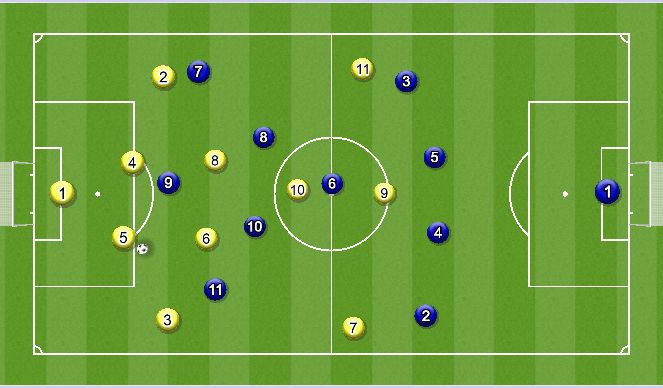Football/Soccer Session (Moderate): Overload Switch of Attack (Playing Behind the Defense on a slow developing switch)
Profile Summary

| Name: | Todd Abbey |
|---|---|
| City: | Fayetteville |
| Country: | United States of America |
| Membership: | Adult Member |
| Sport: | Football/Soccer |








 Play animation
Play animation Play step-by-step
Play step-by-step Repeat (toggle)
Repeat (toggle) Full Screen
Full Screen Pause
Pause Stop
Stop
Overload Switch of Attack
The Objective is to get the opposing team to overload one side of the field from the original pass in order to play the ball behind the defense when the run of play is slow to develop needing an extra pass through the midfield.
Movements:
1. When the initial ball is played, either by the keeper (1) or the Central Back (5), we see the Flank player on the ball side (7) check back and wide in order to draw the opposing team's outside back (2) in towards the midfield and wide. Also, the Striker (9) checks into the midfield as well trying to pull the near side opposing center back (4) with him as well. This will allow the weak side flank player (11) to move underneath the back line, drawing the attention of the other central defender (5) towards the middle of the field. And also pulling the opposing (3) with him/her to give space to our (2) moving into the space the (11) vacated.
2. Once the ball is played from the (3) into the (7), the near side central defending midfielder (6) checks into space to create a angle supporting pass for the (7), with the next intention on opening up and playing a long diagonal ball into the (2) that has occupied the space left by the (11). The central attacking midfielder (10), checks in at an angle passing lane in order to pull the opposing teams (6) with them, causing the overload to the ball side of the field. The other central defending midfielder (8) stays at a deep supporting roll to allow for a square pass if the long ball is cut off, but also for defensive structural purposes in the case of a counterattack. In this example, you can now attribute new numbers if you would like to your players for coaching purposes. (9) > (10); (11) > (9); (2) > (11); (8) > (6); (10) > (8)
3. In this instance, once the ball is played into the (6) from the (7), the (6)'s passing lanes for the long diagonal to the (2) and the square pass to the (8) are both cut off by the opposing teams (10) and (8) respectively.
4. Upon recognizing that both passing lanes are cut off, the (10) checks at more of an angle to allow for an intermediate angled pass that allows for an easier transition to the (8) who opens up wider in the midfield to allow for an outlet.
5. When the extra pass is needed into the (10) this is the reaction point for the attacking position player to start their new movements based on the slower developing switch of play. As you can see, due to the extra pass in the midfield, we now have 1v1 situations on all of the opposing team defensive backs: (7)v(2); (9)v(4); (11)v(5); (2)v(3).
6. It is also the reaction point for our defenders to shift to make sure if we lose the ball in the midfield, that we are tactically solid in case of a counterattack off the lost ball. once the ball is dropped from the (10) to the (8). The (3) gets reconnected, the (6) drops into the (5) role, the (5) slides to the (4) role and the (4) takes up the (2) role. Allowing for us to maintain the (2) high up the field creating the 1v1 situations with their back line. And solidifying our defensive structure.
7. Once the (8) receives the pass from the (10), and understands that due to the extra pass in the midfield, it is now slow developing, he should be looking to play a long diagonal pass back to the original side of the field, looking for the (9) who has changed places with the (7) in order to cause marking confusion between the opposing (2) and (4).
8. At this point, once the (9) collects the pass from the (8), he is looking to pick out the "more open" one of the three runners that were matched up 1v1 tracking into the box. In this examples the (9) picks out the (11) at the far post. And the (10) is now the trailing player in case it is cleared to the top of the box. Defensively we are set up with 4 backs and a man in the hole.